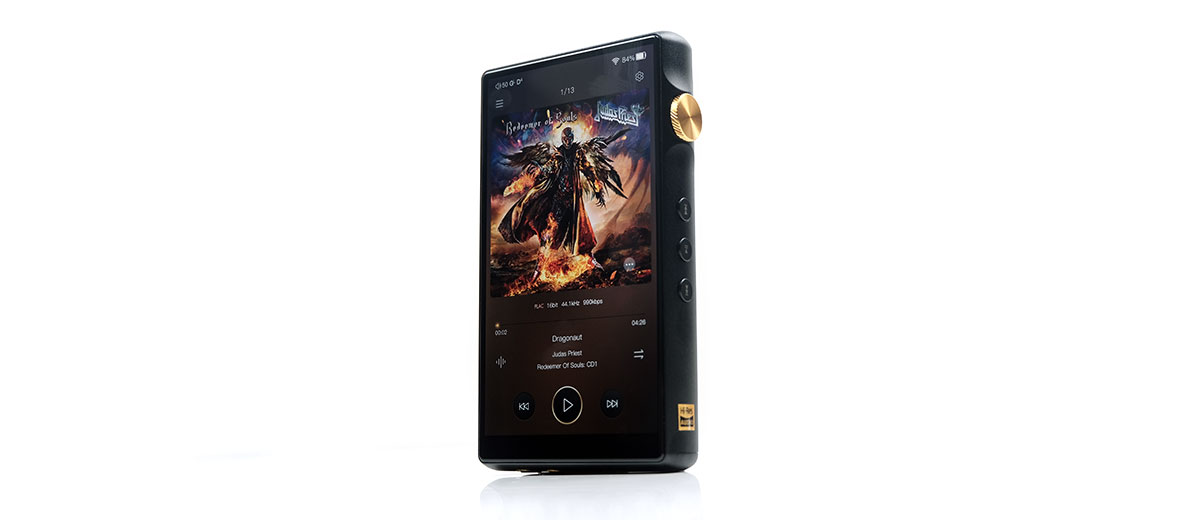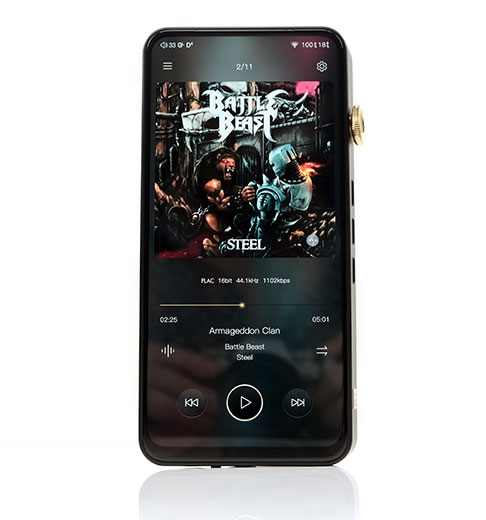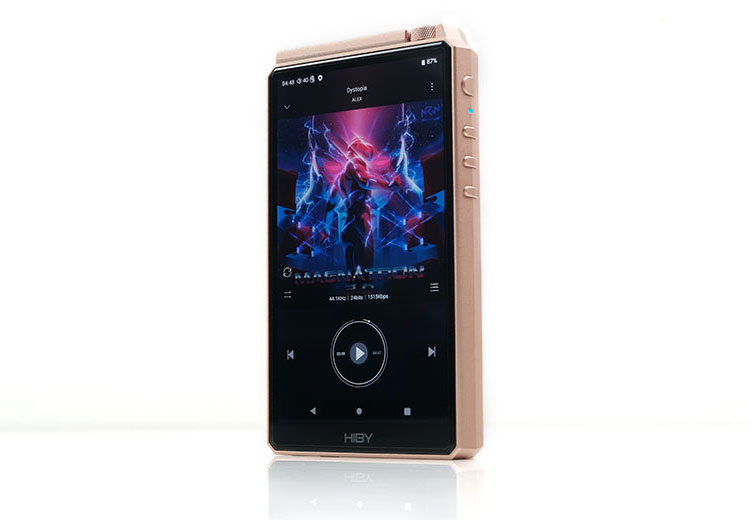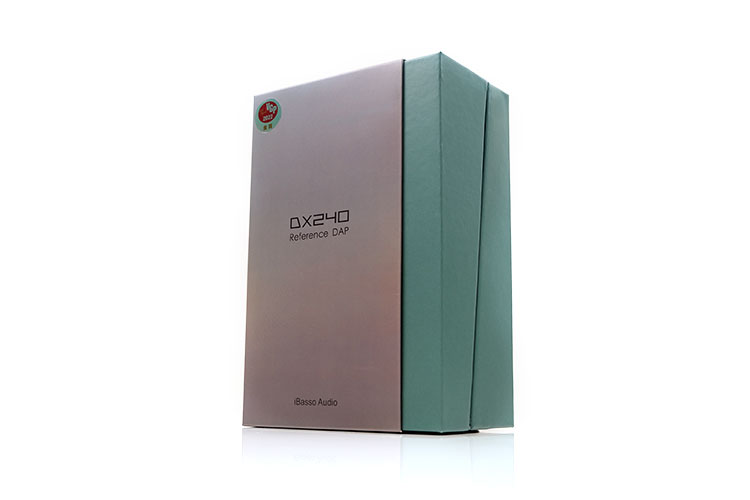Select Comparisons
iBasso DX220
Discontinued (previously $899)
Technical
Superficially there are some shared features between the older DX220 and the DX240 such as the 5″ screen size, swappable amp card capability, 4GB of RAM, and an onboard storage capacity of 64GB.
However, beyond that, it’s an entirely different experience. The introduction of the Snapdragon 660s CPU ensures that the DX240 is measurably faster. That means a smooth scrolling experience, quicker media scanning, and better artwork cache refreshing. Android 9 over Android 8 is also tidier looking with improved app compatibility.
At the same time, the DX240 offers a superior battery life of 1-2 hours without needing to drop from 1080p to 720p to keep the internal CPU clock rate at an appreciably fast level. In fact, the DX220 internal clock rate is double that of the DX220.
The DAC has also been upgraded from a dual ES9028PRO to a single ES9038PRO. Decoding rates stay the same at DSD512 and PCM 32BIT/768kHz but MQA unfolding has been enhanced from 4X to 16X.
Analog outputs will largely depend on the amp card in use but for AMP1 MKIII you get the same configuration as MKII with 2.5mm TRRS, 3.5mm TRS, and 3.5mm variable lineout. I don’t see any changes in the VRMS capability but the improved capacitor choices have lowered the rated THD+N by a further 3dB over the MKII.
Design
The DX240 is more DX160 than DX220 in the design language. The curving feels more nuanced and elegant compared to the more robust industrial design language of the DX220. The DX240 is also lighter by 35g with a curved back that is more comfortable in the hand compared to the DX220.
More nuanced changes include a superior volume rotary interface on the DX240 compared to the tight profile of the DX220 dial, gold plated contacts for the card outputs, and coaxial SPDIF instead of an optical output.
Despite sharing the same screen size, the IPS panel on the DX240 looks better to the naked eye to me than the DX220 version. That is an entirely subjective opinion though because on paper they share the same pixel density specs.
One thing to note is the 1080p rating for the DX220 screen which is fixed. It can be switched to 720p on the DX220 which might affect the perceived quality of the screen output below that of the DX240 which has no such option. It is not an advantage for the DX220 though since it was done to shore up the battery performance of the DX220 under 1080p conditions.
Performance
For this comparison, we stuck to the stock cards initially, and oh boy, what a difference between these two DAPs when in stock mode. The DX240 with AMP1 MKIII is much more dynamic and physical sounding compared to the more ethereal and lighter tone of the AMP1 MKII on the DX220.
I feel sure this is not just a change-up in the card designs either. The new ES9038PRO DAC inside the DX240 may have allowed iBasso a moment to give the presentation a bit of a lift over the DX220’s ES9028PRO implementation.
You can argue that the AMP1 MKIII has more of an upbeat character to it as well as a slightly more natural coloration in the timbre compared to MKII. Of particular note are the lower mids in our test monitor, the MEST MKII. There is an increased emphasis here for bass guitar plucks with a fuller sound which in turn, fills in the stage a bit more.
Vocals also have a fuller intonation on the AMP1 MKIII/DX240 combo compared to the DX220/AMP1 MKII. The DX220 renders head or higher pitching vocals as quite light in timbral coloration and somewhat further back in the mix. The DX240 combo is more robust sounding, a little further forward, and generally has a better harmonic balance to my ear.
I also suspect some of that increased vibrance and fullness comes from a slightly enhanced low-end on the MKIII card and DX240. At times I felt the MEST MKII/DX220 pairing just fell away in sub-bass presence compared to the AMP1 MKII and that robs it a bit of compatible weight and a slightly brighter tone.
iBasso DX300
Discontinued (previously $1199)
Technical
Despite the DX300 coming out before the DX240 and now being discontinued in favor of the soon-to-be-released DX320, it is still the next step up for me in terms of where iBasso wants to do with DAPs.
The quad CS4198 DAC implementation was innovative on the DX300 but I still have a personal bias toward the capability of the ES9038PRO inside the DX240, even though it is just a single channel implementation.
In fact, the DX240 DAC design does have some advantages over the DX300 such as the ability to decode up to DSD512, PCM 768kHz, and also unfold MQA up to 16X as opposed to 8X on the DX300.
Both share the same Snapdragon 66oc CPU and FPGA master technology as well as being able to offer bitperfect output. Jitter control performance ideally should match as does the speed of the UI given both use Android 9. The key user interaction experience differences here will really come down to that huge screen difference, (see in more detail in the design section).
Key areas where the DX300 excel includes onboard storage at 128GB over 4GB, and a better RAM capacity at 6GB over 4GB which should improve buffering capability over the DX240.
The Amp cards are indeed quite different and broadly speaking the DX300 versions offer a bit more power. For example, the AMP11 MKI can deliver a 350mW SE rating under a 32Ω load and an excellent 1240mW balanced into the same load. The best you can manage with the DX240 is the AMP8 MKII at 980mW on a balanced 32Ω load.
Design
It’s all about the size in terms of design between these two DAPs. The DX300 has an almost smartphone slab-like weightier experience dominated by that elongated and beautiful 6.5″ capacitive 60Hz IPS screen. Not only that, but its resolution is higher at 2340×1080 resolution compared to the 1080p 5″ IPS panel inside the DX240.
The pros and cons of this should be obvious. Go with the DX300 if you want that heavy screen real estate and easy-to-read screens. Go with the DX240 if you want a more pocketable or single-hand friendly DAP experience. Both feel as snappy and as responsive as each other which is not that surprising since both have the same Snapdragon 660c CPU inside.
That curved back of the DX240 is the more comfortable of the two also and lowers the possibility of accidentally pressing the physical buttons during use. The DX300 buttons seem tailor-made for me to hit them without noticing when going for single-hand operation.
Battery life in most instances is slightly better on the DX300 with more than 12-13 hours of regular use time compared to around 9-10 for the DX240. The DX300’s split battery management feature is a bit fiddly to manage compared to the single battery design of the DX240. However, you can still charge both inside the Dx300 with a single USB-C input.
Performance
I went with the AMP12 card inside the DX300 for this comparison along with the Vision Ears EXT for the testing pairing.
Of the cards available for the DX3XXX series, the AMP12 card is probably the most reference-like and closer to the AMP1 MKIII/DX240 sound signature. AMP11 MKI is discontinued as far as I am aware and I do not have the MKII of that card available to compare.
I found the DX240/AMP1 MKIII to sound the more vivid and energetic of the two cards but still what I would describe as well-controlled and neither nasally nor too sibilant sounding. Just a little more edge in the attack and a stronger treble presence or sparkle in its timbre.
By comparison, AMP12 with the DX300 is quite linear in its delivery but with a slight drop in comparative treble forwardness. That brings a slightly more natural smoother tone to the mids and treble timbre and will seem more relaxed in its delivery using the EXT compared to the AMP1 MKIII.
Bass texture is a little different also between these two cards. AMP12 delivers more of a pillowy effect on the low-end, slightly more liquid in its attack and a little warmer also. The DX240 combined with AMP1 MKIII is a shade cooler in its bass coloration but also the punchier and tighter sounding of the two.
Overall, though both I would define as relatively neutral, the DX240/AMP1 MKIII delivers the cleaner livelier sound whereas AMP12 offers a slightly softer and smoother tone.
HiBy RS6
$1399
Technical
Hugely different DAP experiences on a technical level. The RS6 does not use a delta-sigma DAC implementation similar to the ES9038PRO inside the DX240. Instead, it’s an R-2R or discreet with a 24BIT resistor ladder network design with individual matching resistors, (within 1/1000), at 48 per channel.
Decoding, however, favors the DX240 for DSD at up to DSD512 and both are capable of PCM decoding up to 32BIT/768kHz as well as MQA 16X unfolding and BT LDAC. Both DAPs can output bitperfect streams that bypass their respect Android capped bitrates for OTG audio.
The OS is similar with both using Android 9 backed by a Snapdragon 660c CPU and 4GB of RAM. The internal CPU clocks rates are the same also with a maximum of 2.2GHz. That means both are more or less the same in terms of responsiveness, and multi-tasking capability which is borne out by almost matching AnTuTu results of approximately 180k for both.
The more interesting software layers are the DSP and NOS capability of the RS6 versus the excellent PMEQ of the Mango App of the DX240. The Darwin architecture of the RS6 is system-wide with some very interesting profiles tuned by industry insiders from key manufacturers.
The PMEQ of the DX240 is app-specific but there is nothing really like it on the RS6 and gives you a high degree of control over specific tuning profiles you can create yourself.
If you need amplification grunt then the DX240 amp card system is the better choice. Its rating of 878mW under a 32Ω load for the AMP1 MKIII and 978mW for the same load for AMp8 MKII dwarfs the 180mW@32Ω SE and 690mW@32Ω balanced rating of the RS6.
Design
The RS6 is only marginally larger than the DX240 but does feel a good bit heavier at 315g compared to the iBasso DAP’s lighter 205g. In its favor, the RS6 is much slimmer with a slightly more refined feel to its chassis finishing though the curving on the DX240 makes it generally the more comfortable to hold and use.
Both DAPs use a beautiful borderless IPS panel screen design with a matching 1080P resolution. The only difference I can make out is the slightly superior pixel density of the DX240 at 448ppi compared to RS6’s 320ppi. It has the effect of making the font on the RS6 a little thinner looking to the naked eye. Otherwise, saturation and legibility are quite similar.
Analog I/O is slightly different given the RS6 has no modular amp card system making it a fixed analog output system. To its credit, the lineout is fixed and not variable with both 3.5mm and 4.4mm LO and PO options.
With AMP1 MKIII on the DX240 you have 2.5mm TRRS, 3.5mm TRS, and a variable 3.5m line out but not balanced 4.4mm options for PO and LO and no line out at all on the AMP8 MKII.
Digital I/O on the RS6 is all via its USB-C whereas the DX240 does have that additional SPDIF Coaxial output on the top panel. Both can deliver OTG audio and flash memory card expansion with their USB-C ports. I would also give a slight edge to the DX240 for battery life with an average of around 9-10 hours and the RS6 around 8 hours or less if using balanced.
Performance
For this comparison, we used the AMP8 MKII for the DX240 paired with Empire Ear’s Legend EVO for both DAPs. For the RS6 we kept the NOS option off and added no additional Darwin presets.
The DX240/AMP8 MKII is the better technical performer for me in terms of dynamic range and staging complexity. However, the RS6 has that R-2R magic with a creamier richer timbre and more inviting liquid-like vocals that push up a little closer and take center stage.
The AMP8 MKII vocal presence is very good also but it does have that delta-sigma texture to it with more focus on detail and rapid articulation and slightly less in terms of emotive coloration. Treble presence and detail are a step up on the AMP8 MKII compared to the RS6 as is the dynamic range throughout.
For example, the RS6 has more bass quantity and spreads it out quite well but it does not have the definition and snap of the AMP8 MKII bass tuning. It’s more of a wall of density that moves a little slower and sounds heavy but less punchy. AMP8 MKII pulls back a little on the bloom and quantity and adds in more definition and slightly better layering.
Staging complexity benefits AMP8 MKII and the DX240 but to be honest I was expecting that. This is a good delta-sigma DAC implementation and I expected it to push out taller and wider with its imaging than the RS6 which is a bit more center and depth focused.
With EVO, you will get the benefits of the RS6 bass density and presence with vocals that sound euphonic and very pleasing. However, the snap and complexity as well as the better imaging and instrumental separation belong to the AMP8 MKII with the DX240.
Our Verdict
The iBasso DX240 is much more than some sort of peace offering to the loyal amp card owners who didn’t wish to upgrade to the new DX3XX card variants. It combines the speed of the DX300 with a more compact form factor and adds some new cards that really do the new flagship ES9038PRO chipset some serious justice.
It is now a punchier, livelier-sounding DAP with a more pleasurable and modern UI interface, one that can easily compete with newer releases from competing DAP companies.
To be honest, in some ways I find the DX240 to be more impressive than the DX300, certainly more capable than the original AMP11/DX300 combo and at times on par with the AMP12. It will be very interesting to see how well it stacks up against the soon to arrive DX320 for sure.
Do I expect to see more DX2XX series DAPs? Probably not, I fear this might be the last one but if it is then iBasso is signing out with an impressive bang rather than a whimper.
iBasso DX240 Technical Specifications
- Stock amp module: AMP1 MK3
- Output ports: 2.5mm TRRS, 3.5mm Single-ended, 3.5mm Line Out
- Display: 5.0” 1080P Full HD
- Battery capacity: 4400mAh
- Charging time: 2.5H
- Playback time: up to 11 hours
- Audio Formats – MQA. APE, FLAC, WAV, WMA, ACC, ALAC, AIFF, OGG, MP3, DFF, DSF, DXD, and DST
- USB C- USB 3.1
- Output Ports – 2.5mm balanced, 3.5mm single-ended, 3.5mm line out, 3.5mm coaxial output, USB OTG output
- WiFi – 802.11b/g/n/ac (2.4Ghz/5Ghz)
- Bluetooth – V5.0
- RAM+ROM – 4G LPDDR4X, 64G ROM
- Battery – 4400 mAh, 3.8V li-polymer battery
- Size – 124mm*71.5mm*19.4mm
- Weight – 205g
Output Parameters (Balanced)
- Maximum output level: 6.2Vrms
- Power: 878mW@32Ω, 128mW@300Ω
- Frequency response: 10Hz-45kHz
- SNR: 125dB
- DNR: 125dB
- THD+N: -114dB
- Resolution: -119dB
- Output Impedance: 0.57Ω
Output Parameters (Single-ended)
- Maximum output level: 3.1Vrms
- Power: 281mW@32Ω, 32mW@300Ω
- Frequency Response: 10Hz-45kHz
- SNR: 123dB
- DNR: 123dB
- THD+N: -110dB
- Resolution: -117dB
- Output Impedance: 0.38Ω
Output Parameters (lineout)
- Output Voltage: 3.0Vrms
- Frequency response: 10HZ-45KHZ+/-0.3dB
- S/N: 122dB
- THD+N: -110dB (no load, 1.8Vrms)
- Crosstalk: -116dB
iBasso AMP8 MKII Specifications
Output Parameters (Balanced)
- Max output level 6.2Vrms
- Output power 980mW @ 32Ω
- 128mW @ 300Ω
- Frequency response 10Hz – 45kHz (±0.3dB)
- SNR 125dB
- Dynamic range 125dB
- THD+N -114dB @ no load
- -113dB @ 300Ω
- -101dB @ 32Ω
- Crosstalk -122dB
- Output impedance 0.55Ω
Output Parameters (Single-ended)
- Max output level 3.1Vrms
- Output power 281mW @ 32Ω
- 32mW @ 300Ω
- Frequency response 10Hz – 45kHz (±0.3dB)
- SNR 122dB
- Dynamic range 122dB
- THD+N -110dB @ no load
- -109dB @ 300Ω
- -98dB @ 32Ω
- Crosstalk -117dB
- Output impedance 0.32Ω





